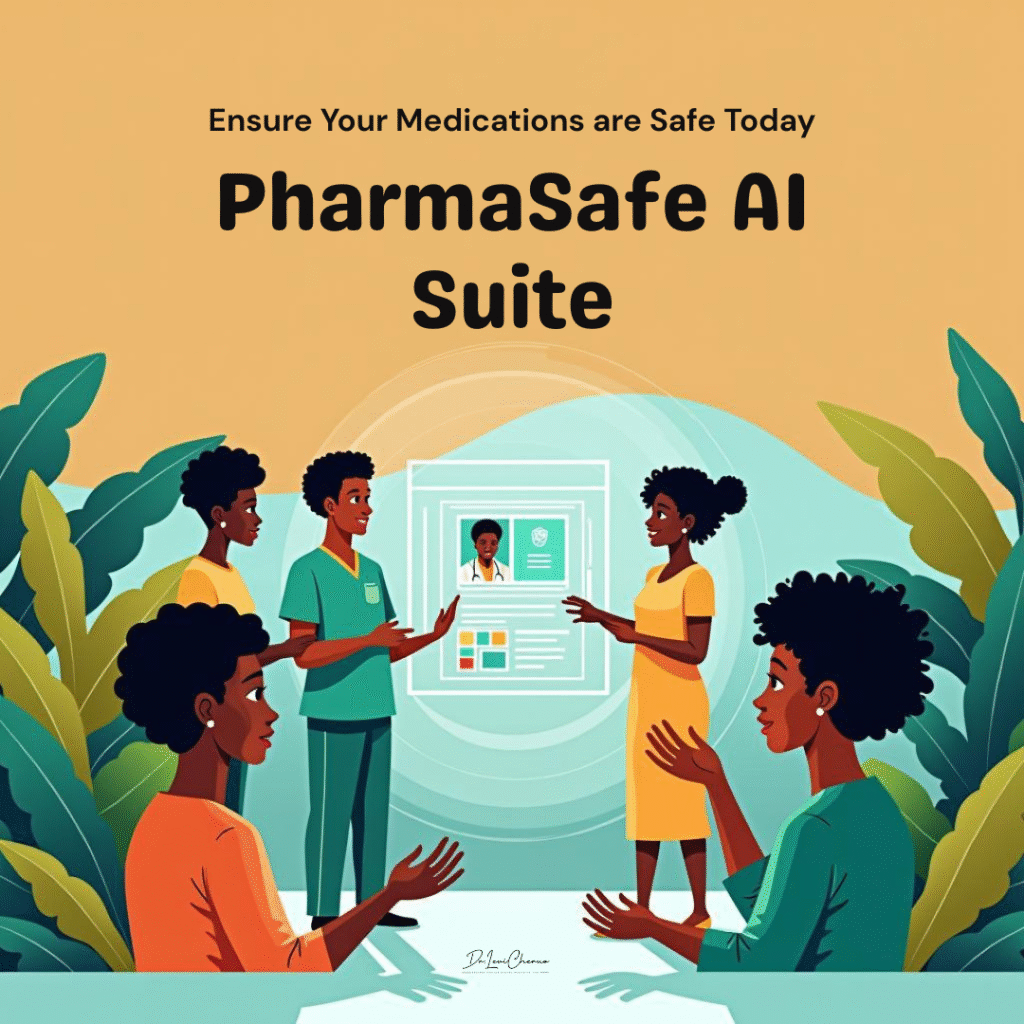
PharmaSafe AI Suite — User Guide for Medication Safety & Authenticity
- September 17, 2025
- 0 Likes
- 458 Views
- 0 Comments
Abstract
Medication-related harm—stemming from adverse drug events (ADEs), medication errors, non-adherence, and falsified/substandard pharmaceutical products—remains a leading and largely preventable cause of morbidity, mortality, and excess health-system cost worldwide (Institute of Medicine, 2000; Bates et al., 1995). PharmaSafe AI Suite is a patient- and clinician-facing integrated platform that combines automated medication reconciliation, clinically aware drug–drug and drug–condition interaction analysis, image-based medication authentication, and regulatory cross-checking into a single workflow. This paper frames the public-health rationale for PharmaSafe, describes its architecture and core algorithms, projects potential clinical and economic impacts supported by extant literature, and proposes an empirical evaluation and deployment agenda. The argument synthesizes foundational evidence on ADE incidence, medication adherence, and falsified medicines to justify the system’s anticipated effect on safety, costs, and pharmacovigilance. Limitations, ethical safeguards, and recommended research methods for rigorous assessment are also presented. A final call to action invites stakeholders to initiate pilot evaluations and regulatory partnerships to validate and scale the approach.
Keywords: medication safety, adverse drug events, counterfeit medicines, clinical decision support, artificial intelligence, pharmacovigilance
Introduction
Adverse drug events (ADEs), medication errors, and the global presence of substandard and falsified medical products (SFMPs) present persistent threats to patient safety and public health. Landmark reports and empirical studies have documented the scale and cost of medication-related harm, underscoring the need for tools that operate at the point-of-use to prevent, detect, and respond to safety threats (Institute of Medicine, 2000; Bates et al., 1995). Simultaneously, the rise of mobile imaging, optical character recognition (OCR), natural language processing (NLP), and machine learning creates an opportunity to deliver actionable decision support directly to patients and pharmacists. PharmaSafe AI Suite integrates these capabilities, offering reconciliation and interaction checking, package and pill authentication, and regulatory cross-referencing. This paper develops an evidence-based rationale for such a system, details its technical and clinical design, and proposes evaluation strategies to test its effectiveness.

Background and Literature Review
The burden of ADEs and medication errors
Numerous studies have documented that ADEs and medication errors are common, costly, and frequently preventable (Bates et al., 1995; Institute of Medicine, 2000). Hospital-based investigations revealed substantive rates of ADEs attributable to prescribing, dispensing, and transcription errors; subsequent work has extended these concerns to outpatient and community settings where fragmented medication records and patient self-management increase the risk (Bates et al., 1995). The Institute of Medicine’s seminal report emphasized system redesign and information technology interventions as key strategies for risk reduction (Institute of Medicine, 2000).
Medication adherence and regimen complexity
Non-adherence remains a large contributor to poor clinical outcomes across chronic conditions; complexity of regimens, poor labeling, and inadequate patient education are repeatedly implicated as drivers (World Health Organization, 2003). Digital tools that reduce ambiguity around dosing and that present personalized risk information can improve adherence and reduce unintentional misuse.
Substandard and falsified medical products (SFMPs)
SFMPs undermine clinical treatment, produce harm, and erode public trust. WHO analyses document both clinical and socioeconomic impacts resulting from exposure to falsified medicines—including treatment failure and contribution to antimicrobial resistance when antibiotics are involved (World Health Organization, 2017). Authentication at the last mile — i.e., when patients receive their medicines — has been proposed as a high-value intervention to detect suspicious products before patient exposure.
Decision support and medication reconciliation
Decision support systems and medication reconciliation tools have been shown to reduce error rates, particularly in controlled settings where integration into clinician workflow is possible (Bates et al., 1995). Extending such support to the patient and pharmacy context—coupled with authentication—creates a combined prevention and surveillance mechanism with benefits for both individual and public health.
System Design and Methods
Objectives and scope
PharmaSafe AI Suite is designed to: (a) perform automated medication reconciliation and personalized interaction analysis at point-of-use; (b) authenticate pharmaceutical packages and solid dosage forms using image-based and identifier-based methods; and (c) link findings to regulatory and pharmacovigilance workflows.
Architectural overview
The Suite comprises five interoperating modules:
- Input Capture Module: Accepts manual entry, image capture (prescriptions, pill bottles, packages), and file upload (PDF prescriptions). Uses OCR and image preprocessing to extract structured text and visual features.
- Normalization and Knowledge Mapping: Maps extracted text to canonical drug identifiers (e.g., generic/brand names, standard dosing units) and links to a curated knowledge base of drug properties (metabolism, therapeutic class, interaction mechanisms).
- Interaction Analyzer: A hybrid rules-based and machine-learned engine evaluates potential drug–drug and drug–condition interactions. It adjusts risk stratification using user-supplied demographics (age group, pregnancy, renal/hepatic impairment) and allergies, producing graded risk categories and actionable recommendations.
- Medication Authenticator: Uses multi-modal computer vision to evaluate packaging security features (QR/barcode validation, hologram detection, seal integrity), OCR of lot and expiry data, and pill identification via imprint OCR and morphological descriptors. Authentication results include probabilistic confidence scores and suggested next steps for suspected SFMPs.
- Regulatory Cross-Check and Audit Trail: Matches resolved identifiers to regulatory records (recalls, label changes, safety communications) and stores timestamped evidence (images, extracted text, analysis outputs) to support investigation and pharmacovigilance reporting.
Algorithms and data sources (design rationale)
The Interaction Analyzer employs a layered approach: deterministic high-sensitivity rules for well-established major interactions (to limit false negatives) combined with machine-learning models trained on curated interaction datasets to surface context-dependent risks. The Authenticator uses convolutional neural networks (CNNs) for image feature extraction and a similarity-matching layer to compare observed package features and imprints to a reference corpus. Confidence thresholds and human-in-the-loop escalation policies are embedded to manage uncertainty and reduce inappropriate alarms.
Privacy, security, and governance
Data minimization, encryption at rest and in transit, and user consent controls are central. De-identified metadata may be shared with public health agencies under pre-specified governance agreements to enable population-level signal detection while maintaining patient confidentiality.

Projected Impacts and Supporting Evidence
Clinical impact: preventing ADEs and harmful interactions
Decision support systems that reconcile medications and flag interactions are empirically associated with reduced prescribing errors and ADE incidence in clinical settings (Bates et al., 1995). By providing patients and pharmacists with immediate, context-aware alerts, PharmaSafe aims to prevent a meaningful portion of community-based ADEs—particularly those caused by unrecognized OTC-prescription interactions and by duplicate therapy.
Economic impact: reducing downstream healthcare utilization
ADE-related ED visits and hospital readmissions impose measurable costs on health systems. Interventions that prevent ADEs therefore offer potential cost savings. Modeling studies of medication-safety interventions frequently demonstrate favorable cost-effectiveness when reductions in hospitalization are achieved; PharmaSafe’s point-of-use model concentrates interventions at a high-yield prevention point (Institute of Medicine, 2000).
Public health impact: SFMP detection and surveillance
Real-time, last-mile authentication increases the probability of detecting SFMPs that escape upstream controls. Aggregated, de-identified signals (e.g., cluster reports of mismatched lot numbers or high-confidence counterfeit indicators) enhance pharmacovigilance capacity and may accelerate recalls and regulatory responses (World Health Organization, 2017).
Behavioral impact: adherence and patient empowerment
Clear, personalized medication reports and interaction explanations may reduce confusion and support adherence. The WHO has emphasized that addressing patient-level barriers to adherence—through improved information and system-level supports—is essential to chronic disease control (World Health Organization, 2003).
Proposed Evaluation Strategy
To rigorously assess efficacy, safety, and economic value, the following multi-tiered evaluation is recommended:
- Feasibility and Usability Testing: Iterative human factors testing across diverse populations (low literacy, older adults) to refine UI/UX. Metrics: task completion rates, time-on-task, and System Usability Scale (SUS) scores.
- Pilot Effectiveness Study: A stepped-wedge or cluster-randomized trial within primary-care clinics and community pharmacies measuring primary outcomes such as incidence of major potential interactions identified pre- and post-intervention, ADE-related ED visits, and pharmacist reconciliation time savings. Secondary outcomes: adherence proxies and authentication yield.
- Economic Evaluation: Cost-effectiveness and budget impact analyses using observed reductions in healthcare utilization from the pilot to estimate return on investment.
- Surveillance Validation: Compare aggregated authentication signals with regulatory case confirmations to estimate positive predictive value (PPV) of suspected SFMP reports.
Limitations and Ethical Considerations
Algorithmic limitations and potential harms
Automated extraction and classification may produce false positives and false negatives; inappropriate instruction or overreliance on the system by users could cause harm. Clear user-facing disclaimers, escalation pathways, and clinician confirmation requirements for major changes are necessary mitigations.
Equity and access
Digital divides—limited smartphone access, language barriers, and variable digital literacy—could create disparities in benefit. Offline-capable modes, multi-language support, and low-bandwidth designs are required to avoid exacerbating inequities.
Data privacy and regulatory compliance
Robust consent processes and compliance with local data-protection laws (e.g., GDPR-equivalent frameworks) must govern deployment. Data sharing with public health authorities requires transparent governance and protection against misuse.
Discussion
PharmaSafe AI Suite operationalizes longstanding recommendations for system-level medication safety interventions by combining reconciliation, interaction analysis, and authentication at the patient-facing edge. The platform’s novelty lies not in any single algorithmic component but in its integrated workflow that couples prevention (interaction alerts) with detection (authentication) and regulatory linkage. If validated in real-world settings, PharmaSafe could yield reductions in preventable ADEs, cost-savings from avoided utilization, and earlier detection of SFMPs—outcomes supported indirectly by decades of medication-safety and public-health literature (Bates et al., 1995; Institute of Medicine, 2000; World Health Organization, 2003, 2017).
The proposed evaluation plan emphasizes robust mixed-methods assessment to ensure both efficacy and equitable benefit. A successful demonstration would warrant broader partnerships with pharmacy chains, regulators, and payers to scale implementation.
Conclusion and Call to Action
Medication-related harm remains a solvable public-health problem. PharmaSafe AI Suite offers a pragmatic, evidence-informed approach to reduce risk at the intersection of patient behavior, pharmacy practice, and regulatory surveillance. The next steps are to:
- Initiate pilots in community pharmacies and primary-care clinics to measure feasibility, safety, and impact.
- Engage regulators to create reporting pathways for authenticated suspicious product signals.
- Secure funding from health systems and payers for controlled evaluations and economic assessments.
- Prioritize equity by designing offline and language-accessible versions and by engaging representative populations during design and testing.
Stakeholders—clinicians, pharmacists, health-system leaders, payers, regulators, and patient advocates—are invited to collaborate on pilot designs, data-sharing agreements, and governance frameworks to validate and scale PharmaSafe’s promise.
References
PharmaSafe AI Suite: Your intelligent assistant for medication safety and authenticity.
Bates, D. W., Cullen, D. J., Laird, N., Petersen, L. A., Small, S. D., Servi, D., Laffel, G., et al. (1995). Incidence of adverse drug events and potential adverse drug events: Implications for prevention. Journal of the American Medical Association.
Hepler, C. D., & Strand, L. M. (1990). Opportunities and responsibilities in pharmaceutical care. American Journal of Health-System Pharmacy.
Institute of Medicine. (2000). To Err Is Human: Building a Safer Health System. National Academy Press.
World Health Organization. (2003). Adherence to Long-Term Therapies: Evidence for Action. World Health Organization.
World Health Organization. (2017). A study on the public health and socioeconomic impact of substandard and falsified medical products. World Health Organization.



Leave Your Comment